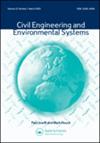Connectivity of two-dimensional assemblies: trusses and roads
IF 1.1
3区 工程技术
Q3 ENGINEERING, CIVIL
引用次数: 0
Abstract
ABSTRACT The concept of ‘structural connectivity’ is introduced to assess the connectivity of structural trusses and road networks, which are examples of two-dimensional assemblies. Metrics for such connectivity, and also for identifying the least connected members and zones, are derived from an adaptation of the ‘Bristol approach’ (based on joint stiffness), Newman’s method (based on network theory), and Route Structure Analysis (developed to analyse road networks). Fractal, Warren and Fan-type trusses of the same triangular outer shape but differing internal geometric configurations were analysed using all three approaches, both to explore similarities across metrics and to find the best-connected truss. Although the different measures gave somewhat different results for the same structure, there was some degree of consistency; thus enabling the Warren truss to emerge as the best-connected configuration. The metrics indicated that truss ends and chord members were the least connected areas and members; but that increasing the axial rigidity of chord members improved the connectivity of all truss forms. An idealised ‘Class A’ road network in Sri Lanka was analysed, using a combination of Newman’s method and Route Structure Analysis, as proof that the concept of structural connectivity could be applied to assemblies other than engineering structures.二维组件的连通性:桁架和道路
引入“结构连通性”的概念来评估结构桁架和道路网络的连通性,这是二维组合的例子。这种连通性的指标,以及识别连接最少的成员和区域的指标,来自于“布里斯托尔方法”(基于关节刚度)、纽曼方法(基于网络理论)和路线结构分析(开发用于分析道路网络)的改编。分形桁架,Warren桁架和扇形桁架具有相同的三角形外部形状,但内部几何结构不同,使用所有三种方法进行分析,都是为了探索度量之间的相似性,并找到最佳连接桁架。虽然不同的测量方法对同一结构给出的结果有些不同,但有一定程度的一致性;从而使沃伦桁架成为最佳连接配置。结果表明,桁架末端和弦杆是连接最少的区域和构件;但增加弦杆的轴向刚度改善了所有桁架形式的连通性。结合Newman的方法和路线结构分析,分析了斯里兰卡理想的“A级”道路网络,证明结构连接的概念可以应用于工程结构以外的组件。
本文章由计算机程序翻译,如有差异,请以英文原文为准。
求助全文
约1分钟内获得全文
求助全文
来源期刊

Civil Engineering and Environmental Systems
工程技术-工程:土木
CiteScore
3.30
自引率
16.70%
发文量
10
审稿时长
>12 weeks
期刊介绍:
Civil Engineering and Environmental Systems is devoted to the advancement of systems thinking and systems techniques throughout systems engineering, environmental engineering decision-making, and engineering management. We do this by publishing the practical applications and developments of "hard" and "soft" systems techniques and thinking.
Submissions that allow for better analysis of civil engineering and environmental systems might look at:
-Civil Engineering optimization
-Risk assessment in engineering
-Civil engineering decision analysis
-System identification in engineering
-Civil engineering numerical simulation
-Uncertainty modelling in engineering
-Qualitative modelling of complex engineering systems
 求助内容:
求助内容: 应助结果提醒方式:
应助结果提醒方式:


